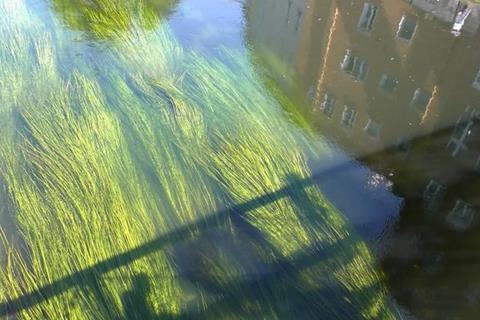During the summer of 2022, a nearly 500 kilometer stretch of the Oder River experienced a decline, resulting in the widespread loss of fish and other aquatic life. The primary cause of this plague was the abrupt proliferation of golden algae, triggered by a combination of various factors.

New research suggests that in the future, the emergence of similar disasters can be foreseen using an innovative statistical method that analyzes the physicochemical parameters of rivers.
The scale of the event was devastating. Despite prompt efforts, Polish and German authorities struggled to identify the cause of this ecological disaster for several weeks. It is now known that a lethal combination of multiple factors contributed to the incident.
Is there a way to prevent similar tragedies in the future? Researchers from Bydgoszcz University of Science and Technology (PBS), Poland, believe there is a possibility to avoid them, but it requires a change in the approach to analyzing parameters recorded at river monitoring stations. The specifics of their proposal were outlined in the scientific journal Science of the Total Environment.
Water quality
Water is a vital element in the Earth’s environment, playing a ubiquitous and crucial role in supporting life. Despite its fundamental importance, no precise methods for evaluating water quality have been established. In countries like Poland, a straightforward classification into five classes has been employed.
Globally, the Water Quality Index (WQI), ranging from 0 to 100, is more widely accepted. This index is a simple weighted average based on various water parameters measured by monitoring stations. The challenge, however, lies in the potential differences in statistical weights and parameter sets, resulting in multiple definitions for the WQI coefficient in practice.
“Most importantly, the WQI suffers from a structural flaw: the basic summation method employed for its calculation allows a positive shift in one parameter to offset a negative shift in another, and vice versa. As a result, the aquatic ecosystem might exhibit significant dynamics that remain undetected in the changes reflected by the index,” explains Dr. Grazyna Czerniak (PBS), the primary author of the article introducing the innovative statistical analysis. She further remarks: “Acknowledging the drawbacks of the WQI coefficient, we opted to develop a new index, statistical, that is more versatile and responsive to variations in individual parameter values.”
Multidimensional analysis
As a chemometrician, Dr. Czerniak engages in multidimensional statistical analysis of physicochemical phenomena. This abstract term encompasses mathematical techniques designed to extract maximal information regarding the dynamics and interrelations of phenomena from measurement data involving various physical quantities within a single system.
Rivers provide an apt illustration in this context. Describing their condition requires knowledge of numerous physical quantities (such as water temperature or its electrical conductivity), chemical quantities (like water acidity, oxygen levels, or specific chemical compound concentrations), and biological quantities (such as diatom or algae counts).
Each available parameter can be treated as an independent dimension within a specific space, where the points correspond to individual measurements – water samples. Through principal component analysis, typically two or three new artificial variables are computed for individual points or samples. These variables are designed to best capture correlations between many parameters.
The final step involves verifying whether the values of these new variables, transformed into one index for individual samples, meet the established statistical quality criterion. In the analysis of water from the Oder, the T2 criterion, introduced by the American statistician Harold Hotelling, turned out to be crucial.
Early data
The basis of the research conducted at PBS was the data derived from physicochemical measurements gathered by more than 30 Polish stations monitoring the Oder. These data spanned from the first days of August 2022 (following the initial observations of dead fish) until mid-May of the subsequent year. The information from the German monitoring station in Frankfurt (Oder) proved to be a valuable addition, including several biological parameters and notably covering the period before the disaster.
“The statistical tests we performed showed that the alarms related to exceeding the Hotelling criterion can be correlated with the press reports about the ongoing pollution of the Oder. What is important here is the fact that the criterion worked as expected both on the maximum set of available parameters and when we limited this set to only three physicochemical quantities,” emphasizes Dr. Czerniak.
The analysis of data preceding the Oder disaster yielded an outcome that was both intriguing and promising. It was revealed that a month prior to the initial fish mortality, the developed statistical index consistently exceeded the alarm criterion, maintaining a slightly fluctuating pattern until the collapse of the river ecosystem, marked by a remarkable peak in the graph. This pattern suggests that the chosen criterion is really sensitive to synergies that may not be immediately apparent, occurring among changes in various physicochemical parameters of the river.
Serious concerns
“Statistical criteria may occasionally generate inaccurate alerts, and a single alarm might be disregarded. However, if the outcomes consistently exceed the alert levels throughout the week, it should raise serious concerns. In the Oder’s case, signs of changes became apparent a month before the disaster. So, if our statistical method had been applied at that time, there would have been a period of two or three weeks for potential preventive actions,” remarks Dr. Czerniak.
The method introduced by physicists from PBS is easy to use, does not require significant computing resources, and is applicable for monitoring various rivers. Nonetheless, the statistical tool needs prior training on a reference set of suitable quality, comprising parameter values representative of the typical state of a particular river. For watercourses already under extensive monitoring, adapting the tool could be quick and cost-effective.
The research received funding from the own resources of Bydgoszcz University of Science and Technology.







No comments yet